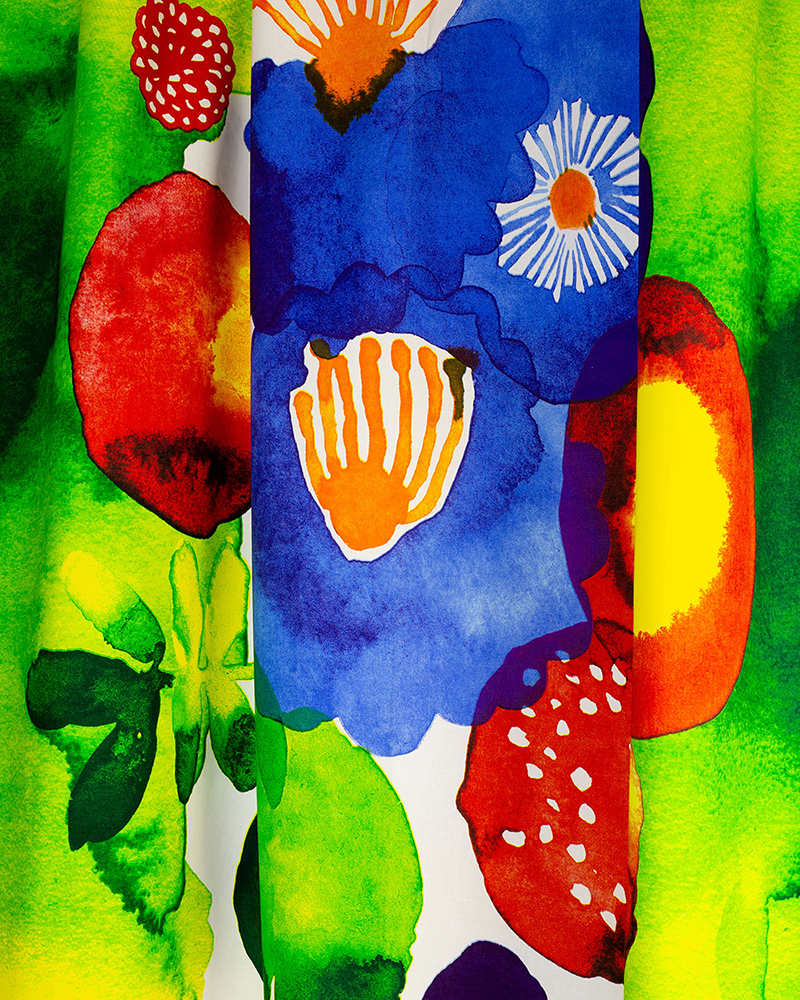
Exhibitions
AINO-MAIJA METSOLA – FABRICS, ILLUSTRATIONS AND WORKS 13 April–15 September 2024
The solo exhibition of Aino-Maija Metsola (b. 1983) at Riihimäki Art Museum offers an extensive cross-section of the works of this versatile designer, illustrator and artist. While Metsola is known as the designer of numerous printed fabrics, the exhibition also showcases a broad selection of her sketches, originals for fabrics, illustrations and works of art. Metsola has produced more than a hundred designs for Marimekko fabrics, clothing, dishes and interior decoration products since 2006. Her best-known designs include Jurmo, Juhannustaika, Napakettu and Ilves as well as the Sääpäiväkirja set. Metsola has also created designs for Aarikka’ spring 2024 collection. Metsola has illustrated several Finnish and international children’s books and also created cover art for reprints of Virginia Woolf’s works (2016–2022), for which she received the Victoria & Albert Museum’s V&A Illustration Award in 2017. This display continues a series of exhibitions at Riihimäki Art Museum focusing on the interfaces of art, fabric design and industrial design and the dialogue between them. The exhibition has been supported by the Finnish Cultural Foundation and the Finnish Illustration Association.
TWO FACES – ARTISTS’ SELF-PORTRAITS 25 November 2023–15 September 2024
The Two Faces exhibition displays artists’ self-portraits and portraits of artists from the collections of Riihimäki Art Museum. Painters are shown in two roles: as artists and persons behind artistic work. Among others, the exhibition contains works of the following artists: Helene Schjerfbeck, Elga Sesemann, Jalmari Ruokokoski, Venny Soldan-Brofeldt, Hugo Backmansson, Tyko Sallinen, Eva Bagge, Eero Nelimarkka, Ingrid Ruin and Arvo Makkonen. This exhibition of more than a hundred works includes a few sculptures and double-sided paintings.
IN HELENE’S SALON – HELENE SCHJERFBECK’S WORKS
In Helene’s salon, a room dedicated to the works of Helene Schjerfbeck (1862–1946), paintings from the collection of Tatjana and Pentti Wähäjärvi donated to Riihimäki Art Museum are on display. The exhibition includes oils and works on paper, especially Schjerfbeck’s recreations of her earlier paintings, such as Silk Shoes and Costume Picture, and a reproduction of a work by the French artist Constantin Guys. The paintings in this mini exhibition showcase key topics of Schjerfbeck’s work, including portraits. Most of these works were painted in the early 20th century. Stylistically, they showcase the artist’s development from subtle portraits to a more modern artistic style.
ARTEFACTS OF THE FINNISH EGYPTOLOGICAL SOCIETY: DAILY LIFE IN ANCIENT EGYPT
The collections of the Finnish Egyptological Society on display at Riihimäki Art Museum focus on daily life in ancient Egypt. The exhibition contains pieces of pottery, a few small artefacts and ostraca. These objects give visitors insights into daily life in ancient Egypt thousands of years ago. The exhibition will be open until late 2024.
VISITING CARDS – IMAGES OF VISITING CARDS FROM RIIHIMÄKI CITY MUSEUM’S COLLECTIONS 16 December 2023–15 September 2024
Riihimäki City Museum The exhibition features visiting cards from the collections of Riihimäki City Museum, the oldest ones of which go back to the 19th century. The visiting cards were photographed at studios that operated in Riihimäki and some larger cities. The visiting cards displayed in the exhibition are mainly copies of original cards in the collection. The exhibition also features a few cameras and visiting card albums.
ANTREA – FROM THE BANKS OF VUOKSI TO RIIHIMÄKI
Riihimäki City Museum’s exhibition titled From the Banks of Vuoksi to Riihimäki showcases the history and objects of war evacuees from Antrea, Karelia, and tells the story of their resettlement in Kanta-Häme after the Continuation War. The rural municipality of Antrea, which was founded in 1724 on the Karelian railway, was located on the upper reaches of the River Vuoksi in the northern part of the Karelian Isthmus, approx. 40 km northeast of Vyborg. In addition to farming, local people found employment in mills, transport, weaving mills as well as the sawmill and stone industry. In 1939, the surface area of Antrea was 486.4 km² and it had 8,772 inhabitants. Finland had to cede Antrea to the Soviet Union in Moscow Peace Treaty in 1944. The people of Antrea then settled mainly in Kanta-Häme area, for example in Vanaja, Janakkala, Hausjärvi, Loppi and Riihimäki. The decision to dissolve the municipality of Antrea was made in Riihimäki in 1948. In the same year Antrea, now part of the Soviet Union, was renamed Kamennogorsk, which means ‘stone town’.
STORY OF THE CHAIR 12 October 2024–20 April 2025
The Story of the Chair, a joint exhibition of Riihimäki Art Museum and City Museum that fills up almost the entire premises, takes the visitor through centuries of history by putting on display chairs, objects, art and cultural history in an impressive visual arrangement. This extensive exhibition focusing on chairs was put together using chairs, antiques and paintings from the collections of Riihimäki Art Museum and City Museum. The Story of the Chair has been supplemented with chairs and other exhibits from the collections of other museums and private owners.